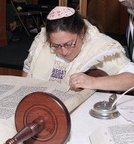“The High Holiday services this year will be my first time ever going to synagogue. I don’t speak Hebrew. What are some things I can do to get something meaningful out of the services?”
First of all, welcome and Shana Tova (Happy New Year)! I am so glad you decided to come to services this year and wish you a year of blessing for you and all your loved ones.
In most communities, High Holy Day services are often the most crowded, intense, and challenging (not to mention longest) of the year. It can be a little daunting to walk into a room full of strangers who all seem to know what’s going on and what to do. Don’t worry. Chances are a lot of other people feel just as lost. There will be regulars who will be happy to help you find your place and welcome you.
There are a number of things you can do to prepare yourself for services before you go. These days, most congregations have websites and often the rabbi and other teachers will have written some preparatory material about the Holy Days for you to read in advance. There are many resources for unpacking and understanding the themes of the prayers and rituals of the season. Websites such as MyJewishLearning.com; URJ.org (Reform movement); Chabad.org (Orthodox) and others have plenty of accessible information. In addition, there are many wonderful books on the subject: Days of Awe by SY Agnon is a classic and This Is Real and You are Completely Unprepared by Alen Lew has become a contemporary must-read for many people at this season.
If you are not the studious type or don’t have the opportunity for pre-service reading, you will still find lots of helpful material and resources once you go to synagogue.
Most congregations in America use prayer books designed with a diverse audience in mind. They contain a significant amount of translation, transliteration (Hebrew written with English letters), commentary, and alternative readings. Even if you are unable to follow along with the prayers as they are recited, you will be able to find meaning and relevance by using the materials at hand. The rabbis and service leaders understand that different people need different things out of the service and will not expect everyone to be on the same page at the same time. Go ahead and read. If something catches your eye that seems meaningful to you, linger on it, read the commentary, and focus on it for a few minutes. When you are ready to rejoin the congregation, listen for the announcement of a page number or inquire of a neighbor. The prayer book is was originally meant to be a guide to aid an inner conversation—use it that way.
Synagogue services contain a great deal of music. Depending on the traditions of the community, there may be a choir, a cantor (an individual specially trained to lead the musical portions of the liturgy), and possibly some instruments. Often, the hope is that people will sing a long, as much as they are comfortable doing so, and the words will be provided. You don’t need to know precisely what each word means in order to enjoy singing in a community. Join in and allow your voice to become part of a larger hole. That experience itself can often be a highlight.
If you are not comfortable participating in this way, simply listening to the sounds of the music and other voices can be inspiring in its own way. Don’t hesitate to close your eyes and let the sounds seep in. Music is very primal. Who knows what certain sounds may evoke for you as you listen?
Speaking of listening, one of the highlights of Rosh Hashanah services is the blowing of the shofar, made from the horn of a ram. Tradition suggests it be blown 100 times on Rosh Hashanah. There are specific parts of the service in which it will be blown. There are many different explanations and interpretations of the shofar blowing. My favorite is that its stark, deeply resonant and piercing quality is designed to both open our hearts to pour out our prayers and open God’s ears to hear them. Regardless of your background, theology, or understanding of this metaphor, the idea is that this simple sound is meant to bridge gap: between human and divine, between our heads and our heart, between our complacent lazy self and our full attention; and this is a powerful idea. When it is time to hear the shofar blowing at services, stand with the community, take a deep breath, close your eyes, and simply listen. Beyond all those unfamiliar words, the strange languages, and crowds of people is this sound—universal, accessible and blown especially for you, just as you are.
May this year be one of light, joy and blessing.
Rabbi Elyse Wechterman is a rabbi with Congregation Agudas Achim, a Reconstructionist synagogue in Attleboro.
You may also enjoy InterfaithFamily’s High Holy Days: The Basics booklet explaining the High Holy Days, what to expect, customs and traditions, from Rosh Hashanah through Yom Kippur.
This post has been contributed by a third party. The opinions, facts and any media content are presented solely by the author, and JewishBoston assumes no responsibility for them. Want to add your voice to the conversation? Publish your own post here. MORE


